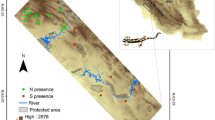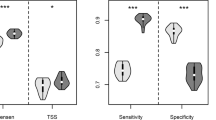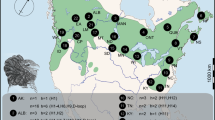Abstract
Species distribution models (SDM) have been proposed as valuable first screening tools for predicting species responses to new environmental conditions. SDMs are usually conducted at the species level, assuming that species-environment relationships are a species-specific feature that do not evolve and show no variability across a species’ range. However, broad environmental tolerances at the species level can encompass narrower and different environmental tolerances for specific lineages or populations. In this study, we evaluate whether SDMs that account for within-taxon niche variation in climate and human-habitat associations provide better fits between projected distributions and real occurrence data for alien bird species than species-level SDMs. Our study focuses on eight alien bird species with established alien populations for which detailed phylogeographic information was available. Similarity in climates and human disturbance conditions occupied by different phylogenetic groups within species was low and not greater than random expectations. Accounting for intraspecific niche variation in SDMs modified the distribution and extent of suitable habitat predicted as susceptible to invasion, but did not result in more accurate model predictions in alien ranges. Until more accurate information on intraspecific variability is available, species-level models can be reasonable candidates. When phylogeographic information is available, the use of the most conservative criterion (i.e. to model both species and lineages on the basis of the actual range) is recommended.



Similar content being viewed by others
Data availability
All data used in this manuscript have already been published or archived and can be accessible via Figshare https://doi.org/10.6084/m9.figshare.4234850, (Dyer et al. 2016) GBIF.org (2018—for a complete list of GBIF occurrence downloads see Table S1), WorldClim database (Hijmans et al. 2005) available for download from http://www.worldclim.org, BirdLife International & NatureServe (2014) available for download from http://datazone.birdlife.org/species/requestdis and terrestrial ecoregions of the world (Olson et al. 2001) available for download from http://www.worldwildlife.org/publications/terrestrial-ecoregions-of-the-world. Data on geographic extent and accuracy of model projections derived from this article is accessible via Figshare https://doi.org/10.6084/m9.figshare.16697881.
Code availability
Code associated with this manuscript is accessible via Figshare https://doi.org/10.6084/m9.figshare.16697881.
References
Abellán P, Carrete M, Anadón JD et al (2016) Non-random patterns and temporal trends (1912–2012) in the transport, introduction and establishment of exotic birds in Spain and Portugal. Divers Distrib 22:263–273. https://doi.org/10.1111/ddi.12403
Abellán P, Tella JL, Carrete M et al (2017) Climate matching drives spread rate but not establishment success in recent unintentional bird introductions. Proc Natl Acad Sci USA 114:9385–9390. https://doi.org/10.1073/pnas.1704815114
Araújo MB, Peterson AT (2012) Uses and misuses of bioclimatic envelope modeling. Ecology 93:1527–1539. https://doi.org/10.1890/11-1930.1
Ascensão F, Latombe G, Anadón JD et al (2020) Drivers of compositional dissimilarity for native and alien birds: the relative roles of human activity and environmental suitability. Biol Invasions. https://doi.org/10.1007/s10530-020-02196-7
BirdLife International, NatureServe (2014) Bird species distribution maps of the world..
Blackburn TM, Duncan RP (2001a) Determinants of establishment success in introduced birds. Nature 414:195–197. https://doi.org/10.1038/35102557
Blackburn TM, Duncan RP (2001b) Establishment patterns of exotic birds are constrained by non-random patterns in introduction. J Biogeogr 28:927–939
Blackburn TM, Lockwood JL, Cassey P (2009) Avian invasions. The ecology and evolution of exotic birds. Oxford University Press, Oxford
Broenniman O, Petitpierre B, Randin C, et al (2014) Package ‘ecospat’
Broennimann O, Fitzpatrick MC, Pearman PB et al (2012) Measuring ecological niche overlap from occurrence and spatial environmental data. Glob Ecol Biogeogr 21:481–497. https://doi.org/10.1111/j.1466-8238.2011.00698.x
Broennimann O, Treier UA, Müller-Schärer H et al (2007) Evidence of climatic niche shift during biological invasion. Ecol Lett 10:701–709. https://doi.org/10.1111/j.1461-0248.2007.01060.x
Broxton PD, Zeng X, Sulla-Menashe D, Troch PA (2014) A global land cover climatology using MODIS data. J Appl Meteorol Climatol 53:1593–1605. https://doi.org/10.1175/JAMC-D-13-0270.1
Capinha C, Essl F, Seebens H et al (2015) The dispersal of alien species redefines biogeography in the Anthropocene. Science (80-) 348:1248–1251. https://doi.org/10.1126/science.aaa8913
Cardador L, Blackburn TM (2020) A global assessment of human influence on niche shifts and risk predictions of bird invasions. Glob Ecol Biogeogr 29:1956–1966
Cardador L, Blackburn TM (2019) Human-habitat associations in the native distributions of alien bird species. J Appl Ecol 56:1189–1199. https://doi.org/10.1111/1365-2664.13351
Cardador L, Carrete M, Gallardo B, Tella JL (2016) Combining trade data and niche modelling improves predictions of the origin and distribution of non-native European populations of a globally invasive species. J Biogeogr 43:967–978. https://doi.org/10.1111/jbi.12694
Cardador L, Lattuada M, Strubbe D et al (2017) Regional bans on wild-bird trade modify invasion risks at a global scale. Conserv Lett 10:717–725. https://doi.org/10.1111/conl.12361
Cardador L, Tella J, Anadón J et al (2019) The European trade ban on wild birds reduced invasion risks. Conserv Lett 12:e12631
D’Amen M, Zimmermann NE, Pearman PB (2013) Conservation of phylogeographic lineages under climate change. Glob Ecol Biogeogr 22:93–104. https://doi.org/10.1111/j.1466-8238.2012.00774.x
Dyer EE, Redding DW, Blackburn TM (2016) Data from: The global avian invasions atlas, a database of alien bird distributions worldwide. Figshare. https://doi.org/10.6084/m9.figshare4234850
Dyer EE, Redding DW, Blackburn TM (2017) The global avian invasions atlas, a database of alien bird distributions worldwide. Sci Data 4:170041. https://doi.org/10.1038/sdata.2017.41
Elith J, Kearney M, Phillips S (2010) The art of modelling range-shifting species. Methods Ecol Evol 1:330–342. https://doi.org/10.1111/j.2041-210X.2010.00036.x
Gaston KJ (2003) The structure and dynamics of geographic ranges. Oxford University Press, New York
GBIF.org (2017) GBIF Home Page
Godefroid M, Rasplus J-Y, Rossi J-P (2016) Is phylogeography helpful for invasive species risk assessment? The case study of the bark beetle genus Dendroctonus. Ecography (cop) 39:1197–1209. https://doi.org/10.1111/ecog.01474
Guisan A, Petitpierre B, Broennimann O et al (2014) Unifying niche shift studies: Insights from biological invasions. Trends Ecol Evol 29:260–269. https://doi.org/10.1016/j.tree.2014.02.009
Guisan A, Thuiller W (2005) Predicting species distributions: offering more than simple habitat models. Ecol Lett 8:993–1009
Haring E, Gamauf A, Kryukov A (2007) Phylogeographic patterns in widespread corvid birds. Mol Phylogenet Evol 45:840–862. https://doi.org/10.1016/j.ympev.2007.06.016
Hijmans RJ, Cameron SE, Parra JL et al (2005) Very high resolution interpolated climate surfaces for global land areas. Int J Climatol 25:1965–1978
Hirzel AH, Gwenaëlle LL, Helfer V et al (2006) Evaluating the ability of habitat suitability models to predict species presences. Ecol Modell 1999:142–152. https://doi.org/10.1016/j.ecolmodel.2006.05.017
Holderegger R, Kamm U, Gugerli F (2006) Adaptive vs. neutral genetic diversity: implications for landscape genetics. Landsc Ecol 21:797–807. https://doi.org/10.1007/s10980-005-5245-9
Hulme PE (2009) Trade, transport and trouble: Managing invasive species pathways in an era of globalization. J Appl Ecol 46:10–18. https://doi.org/10.1111/j.1365-2664.2008.01600.x
Hulme PE, Bacher S, Kenis M et al (2008) Grasping at the routes of biological invasions: a framework for integrating pathways into policy. J Appl Ecol 45:403–414. https://doi.org/10.1111/j.1365-2664.2007.01442.x
Huntley B, Green RE, Collingham YC, Willis SG (2007) A climatic atlas of European breeding birds. Durham University, The RSPB and Lynx Edicions, Barcelona
Joseph L, Dolman G, Donnellan S et al (2008) Where and when does a ring start and end? Testing the ring-species hypothesis in a species complex of Australian parrots. Proc Biol Sci 275:2431–2440. https://doi.org/10.1098/rspb.2008.0765
Lecocq T, Harpke A, Rasmont P, Schweiger O (2019) Integrating intraspecific differentiation in species distribution models: Consequences on projections of current and future climatically suitable areas of species. Divers Distrib 25:1088–1100. https://doi.org/10.1111/ddi.12916
Lenormand T (2002) Gene flow and the limits to natural selection. Trends Ecol Evol 17:183–189. https://doi.org/10.1016/S0169-5347(02)02497-7
Liu C, Berry PM, Dawson TP, Pearson RG (2005) Selecting thresholds of occurrence in the prediction of species distributions. Ecography (cop) 3:385–393
Liu C, Wolter C, Xian W, Jeschke JM (2020) Species distribution models have limited spatial transferability for invasive species. Ecol Lett 23:1682–1692. https://doi.org/10.1111/ele.13577
Liukkonen-Anttila T, Uimaniemi L, Orell M, Lumme J (2002) Mitochondrial DNA variation and the phylogeography of the grey partridge (Perdix perdix) in Europe: from pleistocene history to present day populations. J Evol Biol 15:971–982. https://doi.org/10.1046/j.1420-9101.2002.00460.x
Maia-Carvalho B, Vale CG, Sequeira F et al (2018) The roles of allopatric fragmentation and niche divergence in intraspecific lineage diversification in the common midwife toad (Alytes obstetricans). J Biogeogr 45:2146–2158. https://doi.org/10.1111/jbi.13405
Mateo RG, Broennimann O, Petitpierre B et al (2014) What is the potential of spread in invasive bryophytes? Ecography 38:480–487. https://doi.org/10.1111/ecog.01014
McKinney M, Lockwood J (1999) Biotic homogenization: a few winners replacing many losers in the next mass extinction. Trends Ecol Evol 14:450–453
Mori E, Menchetti M, Zozzoli R, Milanesi P (2019) The importance of taxonomy in species distribution models at a global scale: the case of an overlooked alien squirrel facing taxonomic revision. J Zool 307:43–52. https://doi.org/10.1111/jzo.12616
Olson DM, Dinerstein E, Wikramanayake ED et al (2001) Terrestrial ecoregions of the world: a new map of life on Earth. Bioscience 51:933–938
Parmesan C, Ryrholm N, Stefanescu C et al (1999) Poleward shifts in geographical ranges of butterfly species associated with regional warming. Nature 399:579–583. https://doi.org/10.1038/21181
Pearman PB, Amen MD, Graham CH et al (2010) Within-taxon niche structure: niche conservatism, divergence and predicted effects of climate change. Ecography. https://doi.org/10.1111/j.1600-0587.2010.06443.x
Peterson AT (2011) Ecological niche conservatism: a time-structured review of evidence. J Biogeogr 38:817–827. https://doi.org/10.1111/j.1365-2699.2010.02456.x
Peterson AT, Holt RD (2003) Niche differentiation in Mexican birds: Using point occurrences to detect ecological innovation. Ecol Lett 6:774–782. https://doi.org/10.1046/j.1461-0248.2003.00502.x
Peterson ML, Doak DF, Morris WF (2019) Incorporating local adaptation into forecasts of species’ distribution and abundance under climate change. Glob Chang Biol. https://doi.org/10.1111/gcb.14562
Phillips SJ, Anderson RP, Schapire RE (2006) Maximum entropy modeling of species geographic distributions. Ecol Modell 190:231–259. https://doi.org/10.1016/j.ecolmodel.2005.03.026
Pimm SL, Russell GJ, Gittleman JL, Brooks TM (1995) The future of biodiversity. Science (80-) 269:347–350
Redding DW, Pigot AL, Dyer EE et al (2019) Location-level processes drive the establishment of alien bird populations worldwide. Nature 571:103–106. https://doi.org/10.1038/s41586-019-1292-2
Sanderson EW, Malanding J, Levy MA et al (2002) The human footprint and the last of the wild. Bioscience 52:891–904. https://doi.org/10.1641/0006-3568(2002)052[0891:THFATL]2.0.CO;2
Sayol F, Cooke RSC, Pigot AL, Blackburn TM, Tobias JA, Steinbauer MJ, Antonelli A, Faurby S (2021) Loss of functional diversity through anthropogenic extinctions of island birds is not offset by biotic invasions. Sci Adv (in press).
Sheldon FH, Lohman DJ, Lim HC et al (2009) Phylogeography of the magpie-robin species complex (Aves: Turdidae: Copsychus) reveals a Philippine species, an interesting isolating barrier and unusual dispersal patterns in the Indian Ocean and Southeast Asia. J Biogeogr 36:1070–1083. https://doi.org/10.1111/j.1365-2699.2009.02087.x
Smith AB, Godsoe W, Rodríguez-Sánchez F et al (2019) Niche estimation above and below the species level. Trends Ecol Evol 34:260–273. https://doi.org/10.1016/j.tree.2018.10.012
Smith BT, Escalante P, Hernández Bãos BE et al (2011) The role of historical and contemporary processes on phylogeographic structure and genetic diversity in the Northern Cardinal, Cardinalis Cardinalis. BMC Evol Biol. https://doi.org/10.1186/1471-2148-11-136
Soberón J (2007) Grinnellian and Eltonian niches and geographic distributions of species. Ecol Lett 10:1115–1123
Soberon J, Peterson AT (2005) Interpretation of models of fundamental ecological niches and species’ distributional areas. Biodivers Informatics 2:1–10. https://doi.org/10.17161/bi.v2i0.4
Stockwell DRB, Peterson AT (2002) Effects of sample size on accuracy of species distribution models. Ecol Modell 148:1–13. https://doi.org/10.1016/S0304-3800(01)00388-X
Strubbe D, Broennimann O, Chiron F, Matthysen E (2013) Niche conservatism in non-native birds in Europe: niche unfilling rather than niche expansion. Glob Ecol Biogeogr 22:962–970. https://doi.org/10.1111/geb.12050
Strubbe D, Jackson H, Groombridge J, Matthysen E (2015) Invasion success of a global avian invader is explained by within-taxon niche structure and association with humans in the native range. Divers Distrib 21:675–685. https://doi.org/10.1111/ddi.12325
Vitousek PM (1997) Human domination of earth’s ecosystems. Science (80-) 277:494–499. https://doi.org/10.1126/science.277.5325.494
Warren DL, Glor RE, Turelli M (2008) Environmental niche equivalency versus conservatism: quantitative approaches to niche evolution. Evolution 62:2868–2883. https://doi.org/10.1111/j.1558-5646.2008.00482.x
Zink RM, Pavlova A, Drovetski S, Rohwer S (2008) Mitochondrial phylogeographies of five widespread Eurasian bird species. J Ornithol 149:399–413. https://doi.org/10.1007/s10336-008-0276-z
Acknowledgements
We thank all authors and observers who contributed to the datasets on species distributions and phylogeographic patterns, without which this study could not have been possible. This project has received funding from the European Union’s Horizon 2020 research and innovation programme under the Marie Skłodowska-Curie Grant Agreement No. 752149. L.C. also received funding from the Beatriu de Pinós fellowship program (funded by the Catalan Government and EU COFUND program nº 801370). PA is funded by ‘V Plan Propio de Investigación’ of the Universidad de Sevilla (Spain). The authors acknowledge the use of the UCL Myriad High Performance Computing Facility (Myriad@UCL), and associated support services, in the completion of this work.
Funding
This project has received funding from the European Union’s Horizon 2020 research and innovation programme under the Marie Skłodowska-Curie Grant Agreement No. 752149. L.C. also received funding from the Beatriu de Pinós fellowship program (funded by the Catalan Government and EU COFUND program nº 801370). PA is funded by ‘V Plan Propio de Investigación’ of the Universidad de Sevilla (Spain).
Author information
Authors and Affiliations
Contributions
Not applicable.
Corresponding author
Ethics declarations
Conflict of interest
The authors have no conflict of interest to disclose.
Ethics approval
Not applicable.
Consent to participate
Not applicable.
Consent for publication
Not applicable.
Additional information
Publisher's Note
Springer Nature remains neutral with regard to jurisdictional claims in published maps and institutional affiliations.
Supplementary Information
Below is the link to the electronic supplementary material.
Rights and permissions
About this article
Cite this article
Cardador, L., Abellán, P. & Blackburn, T.M. Incorporating phylogeographic information in alien bird distribution models increases geographic extent but not accuracy of predictions. Biol Invasions 24, 683–695 (2022). https://doi.org/10.1007/s10530-021-02673-7
Received:
Accepted:
Published:
Issue Date:
DOI: https://doi.org/10.1007/s10530-021-02673-7




